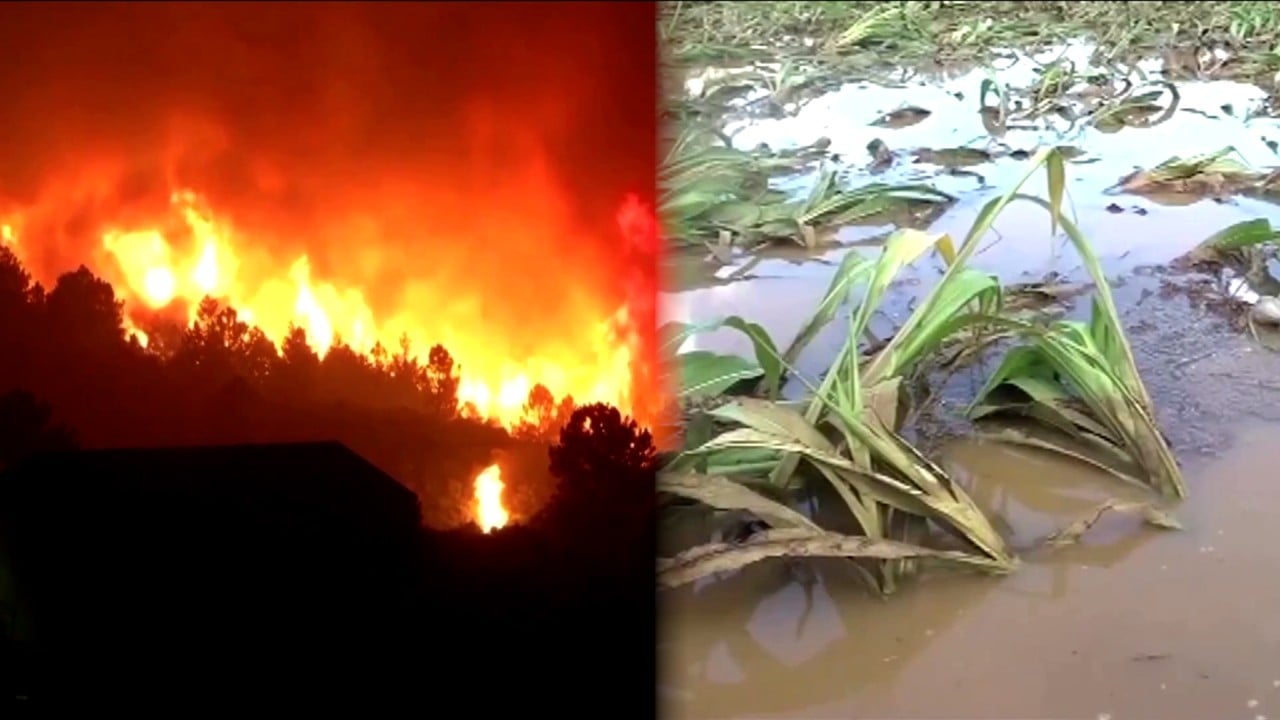UN and EU monitors said the recent heat was probably unprecedented in thousands of years and warned that it was just a taste of the climate’s future.

01:46
Tourists flock to scenic spots in Xinjiang to experience 80 degree Celsius heat
Tourists flock to scenic spots in Xinjiang to experience 80 degree Celsius heat
According to an analysis by Dr. Carsten Haustein, a climatologist at the University of Leipzig, similar warm conditions prevailed only 120,000 years ago.
“Climate change is causing temperatures to rise in many countries around the world, including Singapore. It is therefore important that the public adapts,” the city’s Ministry of Sustainability and the National Environment Agency said in a recent joint statement. Stated.
The region is highly vulnerable to climate change, raising the possibility that Singapore’s efforts will soon be replicated in various forms across Asia.
Recently, deadly floods occurred in northern India and parts of China’s Xinjiang region sweltered at 52.2 degrees Celsius, breaking the previous record high of 50.6 degrees set in 2017.
Heat waves hit China every five years amid frequent abnormal weather: study
Part of the trouble with extreme weather is El Niño, a weather phenomenon that typically disrupts rainfall patterns every few years.
Temperatures in Asia tend to rise during El Niño periods, often making the air humid and warmer.
But scientists say such weather will become more common in the future, thanks to the constant burning of fossil fuels.
“As long as we keep burning fossil fuels, we’re going to see more and more extreme events like this,” said Friederike Otto, senior lecturer in climate science at the Grantham Institute for Climate Change and the Environment at the London School of Economics and Political Science. .
“[But] “Even if we stopped burning fossil fuels now, temperatures would not drop,” she said. “So the heat wave that we’re seeing now, we definitely have to live with that.”
Stopping burning fossil fuels now won’t lower temperatures – Friederike Otto, climate scientist
The heat is already taking a toll on the health of tens of millions of people across Asia who live in marginalized communities with inadequate access to public health services.
Heat-related mortality rates have increased by around 70% globally since the early 2000s, said Marina Romanello, executive director of the Lancet Countdown on Climate Change and Health, which tracks the link between climate change and health. He said there was.
The impact is enormous, with scorching weather severely reducing the ability of people like farmers to work up to 12 hours a day in the fields for generations.
In 2021 alone, approximately 470 billion working hours were lost around the world due to rising temperatures, resulting in approximately US$700 billion in economic losses, Romanello said.
 Villagers try to extinguish a forest fire in Kampar, Riau, Indonesia, in 2019. Photo: AFP There are approximately 450 million smallholder farmers in the Asia-Pacific region. And scientists say the poorest countries, such as Bangladesh, Nepal, Pakistan and Myanmar, are likely to bear the brunt of climate change.
Villagers try to extinguish a forest fire in Kampar, Riau, Indonesia, in 2019. Photo: AFP There are approximately 450 million smallholder farmers in the Asia-Pacific region. And scientists say the poorest countries, such as Bangladesh, Nepal, Pakistan and Myanmar, are likely to bear the brunt of climate change.
Reasons include the time it takes for low-income communities affected by natural disasters to rebuild, the lack of social welfare safety nets, and geographic considerations such as being in vulnerable coastal areas.
High temperatures also pose other hazards, including devastating forest fires.
This week, Indonesian authorities announced that the number of areas susceptible to wildfires doubled between July 17 and July 23 due to dry weather, which left Southeast Asia in a five-month haze. It served as a harsh reminder of the devastating wildfires of 2015.
‘We will face a water crisis’: Malaysia creates rain by forming clouds
“Although not all hotspots will turn into fire spots, we still need to be cautious as we have seen a significant increase,” said a spokesperson for Indonesia’s disaster prevention agency BNPB.
Indonesia’s Meteorological Agency announced this month that the country is expected to experience its harshest dry season since 2019 in the second half of this year, due in part to the El Niño phenomenon.
Aravindan Srinivasan, director of thematic collaboration at the nonprofit Asian Venture Philanthropy Network, which works to alleviate climate stress, said the hot and humid conditions also raised concerns about mosquito-borne diseases such as dengue fever and malaria.
Such diseases were already endemic in Southeast Asia, South America, and sub-Saharan Africa, but are now beginning to spread in uncharted territories such as Europe.
But densely populated Asia remains the most at risk. Srinivasan pointed out that five of the world’s most vulnerable countries to climate change are located in this region: India, China, Bangladesh, Pakistan and Indonesia.

02:50
Climate scientists say El Niño is here and is extremely worrying.
Climate scientists say El Niño is here and is extremely worrying.
Prioritize the health of the planet
Headquartered in Singapore, Srinivasan’s network has 600 members, including philanthropists and large corporations, and is passionate about funding mitigation and renewable generation programs in Asia. The company has been operating in India for the past six months and plans to start operations in China and Southeast Asia soon.
Srinivasan said his nonprofit network works with grassroots businesses and works with various organizations to identify community problem-solving programs, such as working with the government to paint rooftops to reduce the heat. However, these efforts often face financial difficulties.
“We need to look at both sides of the coin: mitigation and adaptation,” he added.
Mitigation and adaptation are becoming increasingly important as extreme weather events threaten to spike electricity demand to power air conditioners and blowers, further increasing emissions.
Power consumption records have been broken in several Chinese cities recently, with Shanghai reportedly burning hundreds of tons of coal every hour to keep its cities cool, while other countries such as Vietnam People are having to deal with rolling blackouts. People cool off on a beach under the blazing sun in Qingdao, Shandong province, China, last Tuesday. Photo: AFPC Climate activists are now eyeing the UN climate change conference in Dubai at the end of the year, hoping for a deal to phase out fossil fuels and increase renewable energy. . But they argue that countries need to prioritize the environment.
People cool off on a beach under the blazing sun in Qingdao, Shandong province, China, last Tuesday. Photo: AFPC Climate activists are now eyeing the UN climate change conference in Dubai at the end of the year, hoping for a deal to phase out fossil fuels and increase renewable energy. . But they argue that countries need to prioritize the environment.
Julie Arrighi, director of the Red Cross and Red Crescent Climate Center in The Hague, Netherlands, said balancing energy demand with reducing emissions is key to preventing more frequent and intense heat waves.
Asian countries are often tempted to rely on coal-fired power generation because fuel is readily available in the region, but experts say this strategy is fraught with risks amid climate change. .
Grant Hauber, strategic energy finance advisor at the Institute for Energy Economics and Financial Analysis, says that thermal power generation facilities (often powered by energy produced by coal- or gas-fired steam boilers) He said it doesn’t operate as efficiently in very hot climates.
He noted that such facilities often suffer from reduced production capacity when it is very hot. In 2021, around 62 percent of the world’s electricity came from fossil fuels, according to energy think tank Ember.
Will Asia finally move away from dirty fossil fuels and embrace green energy?
The International Energy Agency said on Thursday that global coal consumption will hit a record high in 2022 and remain at that record level this year as strong growth in power generation and industrial use in Asia outweighs declines in the United States and Europe. announced that it would remain at a similar level. .
Coal use last year increased by 3.3% to 8.3 billion tons.
ANZ Bank recently said demand in Asia has remained strong over the past few weeks as China ramps up coal-fired power generation.
But experts say falling prices for renewable energy mean demand in Asia is likely to shift further toward green resources in the long term.
“It’s becoming more and more likely that renewables will actually step in to fill the gap,” Hauber said, noting that solar power was replaced last month during a heat-related outage at a gas-fired power plant in Texas. He pointed out that he saved the scene.
Additional reporting by Agence France-Presse

